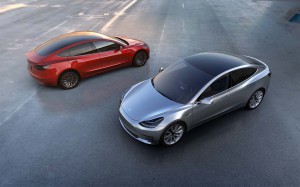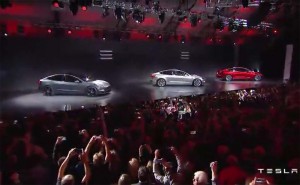Tesla has promised that its upcoming Model 3 will be loaded with a variety of high-tech features, including the latest version of the maker’s semi-autonomous Autopilot system. And now, automotive analysts from Morgan Stanley are predicting the sedan will be the safest car ever made.
With “a supercomputer in every car,” they estimate in a new report that the new Model 3 will be 10 times safer than existing vehicles – or 90% less likely to be the cause of either vehicle-to-vehicle or vehicle-to-pedestrian fatal crashes. But that actually could disrupt both the conventional new and used car markets, Morgan Stanley is forecasting.
“Look for an acceleration of the market’s awareness of the obsolescence of used cars and an acceleration of insurance company awareness to reprice premiums,” the report suggests.
(Why did Tesla drop the base version of its Model S? Click Here to find out.)
Whether Tesla will deliver the breakthrough safety advocates are seeking remains to be seen. The new Model S won’t go into production until July, according to CEO Elon Musk, and retail deliveries won’t start until later in the year – though Tesla hopes to generate as much as 500,000 sales in 2018, the Model 3 responsible for as much as three-quarters of those.
But few experts doubt that increasingly sophisticated high-tech hardware and software – especially autonomous vehicle systems – will yield a radical transformation on the road. Mark Rosekind, who stepped down as the director of the National Highway Traffic Safety Administration in January, set a goal of zero highway fatalities in the coming years. And even skeptics expect the numbers to decline radically from the more than 35,000 motorists, pedestrians and cyclists killed in 2016.
The first semi-autonomous systems are already on the road. Volvo, for example, has introduced software on its new S90 and V90 models that allows a driver to take hands off the wheel for a limited period of time.
Tesla claimed the same with the first-generation Autopilot system, but has since backed down on claims for the technology due to several incidents involving Autopilot – most notably a fatal Florida crash last May that took the life of a former Navy SEAL. Federal regulators have since ruled that Joshua Brown contributed to the incident by not being prepared to take control in an emergency. In this case, the Autopilot system failed to recognize a truck turning into the Model S sedan’s path.
Tesla has since upgraded both the hardware and software used for Autopilot and is adding that to the latest version of the Models S and X, and will include it on the Model 3.
Not everyone is as confident as Tesla and Morgan Stanley. The Tesla system relies primarily on its radar sensors to get a view the world and then analyze it with the car’s onboard computer system. Other makers are using a so-called “sensor fusion” blending radar with camera and LIDAR data. LIDAR is a high-resolution, 3D form of laser.
One thing that will help, according to Morgan Stanley, is that Tesla will be flooding the market with new Model 3 sedans – if it hits its sales targets, and they will all share data, learning from what they experience in day-to-day driving.
“We estimate Tesla’s 5 million miles per day today (clocked by its current fleet of vehicles) can double over the next 15 months,” the report said, adding that, “By 2025 to 2030, we estimate Tesla’s cars could reasonably harvest around 400 million miles per day.”
To put that into perspective, that’s about four times the mileage that Uber’s fleet of ride-sharing vehicles currently clocks. Uber, incidentally, is starting to field its own fleet of autonomous vehicles, with tests underway in California, Arizona and Pennsylvania. But recent reports have underscored the challenges of getting advanced safety technologies to live up to expectations. Human operators had to take control of Uber’s pilot vehicles, on average, about every 0.8 miles during a week-long period in March.
(For more on Uber’s autonomous vehicle problems, Click Here.)
Whether Tesla really will disrupt the existing automotive market, both used and new, is also uncertain. The average vehicle on U.S. roads is no about 11 years old, according to industry data. And there have been lots of major safety upgrades during that period, yet not everyone wants – or can afford to buy – the newest vehicles with the latest safety gear.
But, so far, those safety improvements have been incremental. The Morgan Stanley report is based on a transformative revolution that goes far beyond anything we’ve ever seen before.
(Click Here to see why automakers are rushing to launch their own unlimited in-car data plans.)



